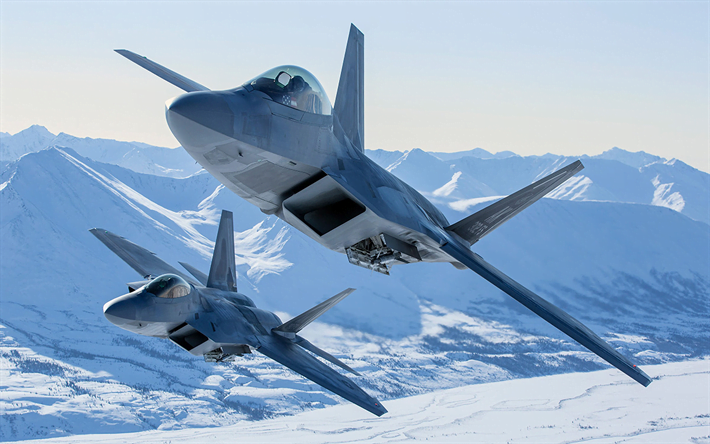Lockheed Developing Advanced, Disposable Drones To Support Air Force Fighters

- The animated movie demonstrates how other intelligence, surveillance, and reconnaissance drones locate concealed surface-to-air batteries and transmit that information to the flying F-35s.
- According to Clark, Lockheed is working on employing Joint All-Domain Command and Control technology to connect the drones to the F-35s.
For the U.S. Air Force to support its manned fighters, Lockheed Martin is considering a combination of disposable drone wingmen and more sophisticated autonomous systems.
The company’s advanced development projects branch, known as Skunk Works, vice president and general manager, stated on July 11 that the service may fly the disposable drones in as little as three years.
The expendable drones will be far less expensive than the more sophisticated systems, according to John Clark, who stated this during a press briefing before the Farnborough Airshow, which will take place in London from July 18 to 22. This will facilitate a quicker delivery.
Top U.S. Air Force officers have warned that a battle with China could break out this decade, and Lockheed wants those disposable drones on hand in case it does. For our people in the Pacific to have that item in their arsenal in case they need it, Clark said, “We’re truly talking about something that might be operational in the next three to four years.”
According to Clark, the more advanced systems may begin to appear in the 2030s. He noted that they would have other capabilities, such as the capacity to return to base for recycling after each operation. In accordance with the Air Force’s Agile Combat Employment strategy, which calls for the establishment of more austere, dispersed locations, often with the use of bumpy runways, Lockheed anticipates such drones returning to those bases.
The agency has been working on giving drones autonomy and artificial intelligence for years. Frank Kendall, the secretary of the Air Force, has frequently expressed his desire to team up to five drones with manned fighters like the F-35 or the Next Generation Air Dominance platform. Earlier this year, Kendall stated that one of his primary priorities was to make the concept of crewed-uncrewed teaming a reality.
As older airframes like the F-16 begin to degrade, Clark said pairing these uncrewed systems with manned aircraft might help the Air Force sustain its combat capability in the coming decade. According to Clark, Lockheed envisions these drones functioning as a “distributed squad,” each with a specific coordinated duty to perform and supporting the piloted fighter.
The release of photographs of the drones Skunk Works is developing, according to Clark, could give away some of its more cutting-edge design concepts.
However, a Lockheed concept movie provides an example of how this remote team concept might operate. It displays an animation of an F-35 flying alongside many different drones, one of which has a flying wing design resembling the B-21.
In the video, a formation of F-35s and accompanying drone swarms fly into an area of intense air competition, with some drones acting as target decoys to divert enemy surface-to-air missiles while others engage in electronic warfare against the air defences.
The animated movie demonstrates how other intelligence, surveillance, and reconnaissance drones locate concealed surface-to-air batteries and transmit that information to the flying F-35s. Then, under the control of the F-35 pilots, a second squadron of armed drones flies forward and destroys hostile aircraft.
According to Clark, it’s critical that advanced drones used to support piloted aircraft have radar signatures and survivability that are equivalent to those of the manned aircraft in the lead to avoid accidentally alerting the enemy.
While this raises the price, he pointed out that it also gives the Air Force a better chance of getting the sophisticated drones returned and able to fly once more.
The drones, he added, could move more slowly or more quickly than the fighter in the lead, and the idea would still hold true.
For instance, four to eight additional AIM-120 Advanced Medium-Range Air-to-Air Missiles might be carried by a drone working alongside a piloted F-35, according to Clark. He claimed that increasing the firepower of the squad of piloted jets and drones would increase their chances of completing the operation.
According to Clark, Lockheed is working on employing Joint All-Domain Command and Control technology to connect the drones to the F-35s. A low-Earth orbit constellation of remote sensor satellites that might provide intelligence to a Next Generation Air Dominance fighter or B-21 Raider bomber was an early idea the business examined, according to Clark.
After that, Lockheed changed its focus to consider cheap, disposable aeroplanes. In a confrontation where the Air Force is expected to lose several drones quickly, according to Clark, this would be crucial. According to Clark, if each car costs $10 million, the expenses mount up quickly.
He also noted that the logistics needed to retrieve and maintain drones so they can fly again might be significant. If this requires utilising the Navy to recover drones that have splashed down in the water, the service vessel may be put in danger.
According to Clark, Skunk Works has occasionally considered the disposable drones to be effectively lingering bombs. In such case, he claimed, the drone would perform as many tasks as it could before colliding with a target and “really ending with a boom.”
Lockheed has also tested how autonomous and artificial intelligence software could function with an F-16 in collaboration with the Air Force Test Pilot School at Edwards Air Force Base in California.
According to Clark, “one of the things we tested was that the uncrewed vehicle had passive sensors that were fixated on and focusing on what the crewed system was doing.” It would modify its actions and assessments in response to what it was seeing.
Above all else, he continued, the human pilot didn’t have to pay close attention to piloting the drone partner.
If we overburden the system’s pilots, we won’t ever implement these kinds of crewed-uncrewed teaming notions, according to Clark. “They already have a lot on their plates with maintaining their own aircraft and working together in, say, a four-fighter formation of an F-35. It is actually not a tenable course of action to go load direct control of a number of uncrewed vehicles on top of them.







Facebook Comments